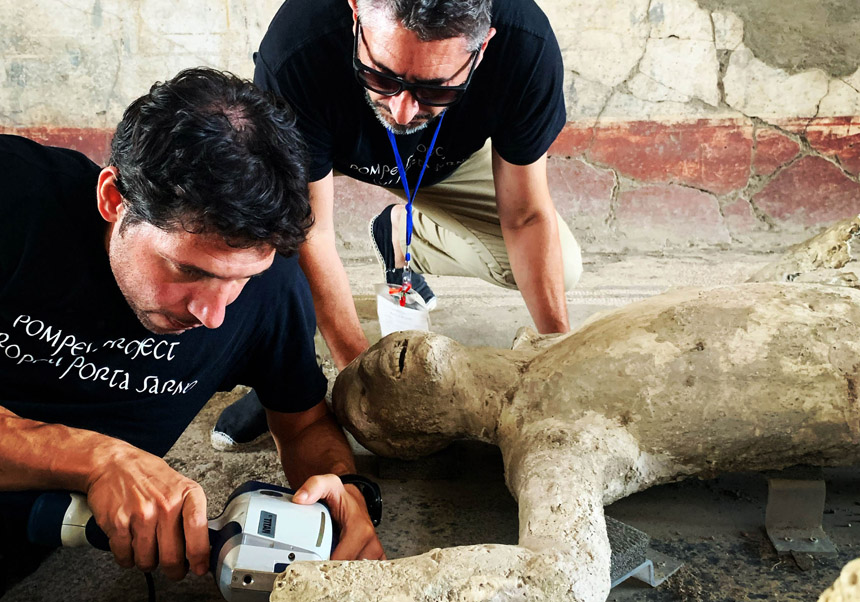First X-ray fluorescence chemical analysis of Pompeii Casts confirms death by suffocation
- Scientific Culture and Innovation Unit
- August 23rd, 2023

An international research team led by the University of Valencia, in which the University of Cambridge and the Italian Ministry of Culture participate, has analysed for the first time the bones of the Pompeii Casts (the skeletons of its inhabitants in a plaster mould) with an innovative technique, x-ray fluorescence analysis, and concludes that they died of suffocation, not burned or dehydrated as other theories defend. The study published today in the journal PLOS ONE is a pioneer in crossing chemical, anthropological, taphonomic and stratigraphic data, and creates a methodology applicable to all traces of the Vesuvius eruption of the year 1979.
During the eruption, in Pompeii the bodies were covered with ash and pyroclastic materials, which were covered by lava and solidified. With the disappearance of the bodies, the bones, some fabrics and the hollow of the bodies among the solidified ashes remained, the so-called voids. Since 1860, the archaeologist Giuseppe Fiorelli put into practice a method to obtain plaster casts of the victims (Casts), which reconstruct each body to a full scale in the position in which it died.
“This is the first time that a permit has been granted to carried out chemical analyses in the Pompeii Cast bones”, highlight Gianni Gallello, coordinator of the research unit ArchaeChemis, and Llorenç Alapont, researcher, both from the University of Valencia, the first two authors of the article, who describe this analysis as an “extraordinary opportunity that creates the bases for a non-invasive analysis that allows us to obtain useful information to identify postdepositional processes around the time of death and post mortem, and to determine the effect of lime on bone materials from Pompeii”.
“In this study we have created a calibration model using reference collections (burnt bones from Pompeii), and other burnt bones from the Ostian necropolis in Rome from the same period, and the two groups compared with bones from the Islamic necropolis of Colata (Montaverner, Valencia). The bones and the lime have been analysed, and the elemental data have been crossed with those obtained in the tracings”, Gallello highlights. Specifically, the team has worked with the remains of six people in Pompeii who were fleeing in the Porta Nola area and a seventh in the Suburban Baths.
The research concludes that the high temperatures to which the bones were subjected occurred post mortem with similar results to cremations. “When their bones suffered the effects of the high temperatures caused by the pyroclastic waves and magma currents, the victims had already died, probably from inhaling toxic gases”, points out Llorenç Alapont. The researcher highlights x-ray fluorescence as a non-invasive and portable technique that has made it possible to select bones not contaminated by lime and to identify those subject to thermal shock, which in a favourable case would eliminate them for some types of analyses, especially genetic or isotope.
In burned bones from Rome and Pompeii, the values of Calcium and Phosphorus, the most representative elements of the bone matrix, have been analysed, which were lower than those of the bones from the Valencian necropolis of Colata, but with similar proportions of the ratio between the two elements, which makes it possible to rule out contaminated bones and to identify that the bones of the tracings had suffered a thermal impact.
This information has been completed with the anthropological and taphonomic analysis of the casts, which makes it possible to relate the position and place of the bodies with the thermal impact, and to confirm that they remained that way post mortem. “The victims, in their attempt to escape, suffocated very quickly and were also quickly covered in ash”, says Gianni Gallello. The position of the victims, relaxed or stretched out, some of them covering themselves with pieces of clothing, suggests that the ashes and volcanic gases were what caused their death in seconds, not like in the town of Herculaneum, closest to Vesuvius, where its inhabitants were burned by pyroclastic waves of more than 500 degrees.
The research involved Massimo Osanna, professor of Archaeology at the University of Naples, director of the Pompeii Archaeological Park between 2014 and 2021, and currently general director of the Italian state museums; Marcos Martinón Torres, professor at the McDonald Institute for Archaeological Research at the University of Cambridge and S. Chenery, from British Geological Survey. This research is part of the project “The Archaeology of Death in Pompei”, leaded by Llorenç Alapont.
Reference:
Alapont, Llorenç et al. The Casts of Pompeii: post-depositional methodological insights. PLOS ONE. DOI https://journals.plos.org/plosone/article?id=10.1371/journal.pone.0289378
You can download a video to edit in Spanish of the research explanations by Gianni Gallello here: https://ir.uv.es/Nsi1VAX



















